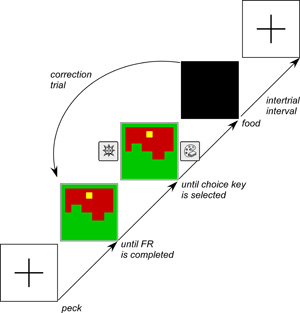
Every moment, organisms—from pigeons to people—are bombarded by visual information. Some of it is relevant, some is noise. How does the visual system decide what to attend to?
One adaptive strategy may be distinguishing figures (important objects) from backgrounds (irrelevant space). Figures are what we act on—backgrounds are what we ignore.
The Task
We developed a behavioral task in which pigeons learned to discriminate whether a target dot appeared on a colored figure or a background region of a display (Lazareva et al., 2006).
The result? Pigeons were faster and more accurate when the target appeared on a figure than on the background. This “figural benefit” was strongest when the figure was small (Castro et al., 2010).
What the Brain Is Doing
In collaboration with Martin Acerbo (Iowa State University), we found that figure-ground segregation is regulated by midbrain structures—specifically, the nucleus rotundus and its inhibitory control center, SP/IPS.
We are now examining metabolic activity in higher-order regions like the entopallium and regulatory centers such as the nucleus isthmi to map the broader visual processing network.